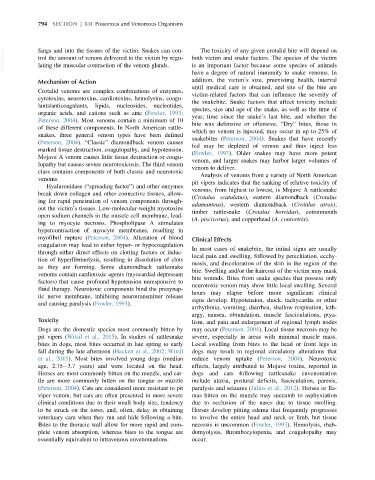Page 836 - Veterinary Toxicology, Basic and Clinical Principles, 3rd Edition
P. 836
794 SECTION | XII Poisonous and Venomous Organisms
VetBooks.ir fangs and into the tissues of the victim. Snakes can con- both victim and snake factors. The species of the victim
The toxicity of any given crotalid bite will depend on
trol the amount of venom delivered to the victim by regu-
is an important factor because some species of animals
lating the muscular contraction of the venom glands.
have a degree of natural immunity to snake venoms. In
Mechanism of Action addition, the victim’s size, preexisting health, interval
until medical care is obtained, and site of the bite are
Crotalid venoms are complex combinations of enzymes,
victim-related factors that can influence the severity of
cytotoxins, neurotoxins, cardiotoxins, hemolysins, coagu-
the snakebite. Snake factors that affect toxicity include
lants/anticoagulants, lipids, nucleosides, nucleotides,
species, size and age of the snake, as well as the time of
organic acids, and cations such as zinc (Fowler, 1993;
year, time since the snake’s last bite, and whether the
Peterson, 2004). Most venoms contain a minimum of 10
bite was defensive or offensive. “Dry” bites, those in
of these different components. In North American rattle-
which no venom is injected, may occur in up to 25% of
snakes, three general venom types have been defined
snakebites (Peterson, 2004). Snakes that have recently
(Peterson, 2004). “Classic” diamondback venom causes
fed may be depleted of venom and thus inject less
marked tissue destruction, coagulopathy, and hypotension.
(Fowler, 1993). Older snakes may have more potent
Mojave A venom causes little tissue destruction or coagu-
venom, and larger snakes may harbor larger volumes of
lopathy but causes severe neurotoxicosis. The third venom
venom to deliver.
class contains components of both classic and neurotoxic
Analysis of venoms from a variety of North American
venoms.
pit vipers indicates that the ranking of relative toxicity of
Hyaluronidase (“spreading factor”) and other enzymes
venoms, from highest to lowest, is Mojave A rattlesnake
break down collagen and other connective tissues, allow-
(Crotalus scutulatus), eastern diamondback (Crotalus
ing for rapid penetration of venom components through-
adamanteus), western diamondback (Crotalus atrox),
out the victim’s tissues. Low-molecular-weight myotoxins
timber rattlesnake (Crotalus horridus), cottonmouth
open sodium channels in the muscle cell membrane, lead-
(A. piscivorus), and copperhead (A. contortrix).
ing to myocyte necrosis. Phospholipase A stimulates
hypercontraction of myocyte membranes, resulting in
myofibril rupture (Peterson, 2004). Alteration of blood Clinical Effects
coagulation may lead to either hyper- or hypocoagulation
In most cases of snakebite, the initial signs are usually
through either direct effects on clotting factors or induc-
local pain and swelling, followed by petechiation, ecchy-
tion of hyperfibrinolysis, resulting in dissolution of clots
mosis, and discoloration of the skin in the region of the
as they are forming. Some diamondback rattlesnake
bite. Swelling and/or the haircoat of the victim may mask
venoms contain cardiotoxic agents (myocardial depressant
bite wounds. Bites from snake species that possess only
factors) that cause profound hypotension unresponsive to
neurotoxic venom may show little local swelling. Several
fluid therapy. Neurotoxic components bind the presynap-
hours may elapse before more significant clinical
tic nerve membrane, inhibiting neurotransmitter release
signs develop. Hypotension, shock, tachycardia or other
and causing paralysis (Fowler, 1993).
arrhythmia, vomiting, diarrhea, shallow respiration, leth-
argy, nausea, obtundation, muscle fasciculations, ptya-
Toxicity lism, and pain and enlargement of regional lymph nodes
Dogs are the domestic species most commonly bitten by may occur (Peterson, 2004). Local tissue necrosis may be
pit vipers (Witsil et al., 2015). In studies of rattlesnake severe, especially in areas with minimal muscle mass.
bites in dogs, most bites occurred in late spring to early Local swelling from bites to the head or front legs in
fall during the late afternoon (Hackett et al., 2002; Witsil dogs may result in regional circulatory alterations that
et al., 2015). Most bites involved young dogs (median reduce venom uptake (Peterson, 2004). Neurotoxic
age, 2.75 3.7 years) and were located on the head. effects, largely attributed to Mojave toxins, reported in
Horses are most commonly bitten on the muzzle, and cat- dogs and cats following rattlesnake envenomation
tle are more commonly bitten on the tongue or muzzle include ataxia, postural deficits, fasciculation, paresis,
(Peterson, 2004). Cats are considered more resistant to pit paralysis and seizures (Julius et al., 2012). Horses or lla-
viper venom, but cats are often presented in more severe mas bitten on the muzzle may succumb to asphyxiation
clinical conditions due to their small body size, tendency due to occlusion of the nares due to tissue swelling.
to be struck on the torso, and, often, delay in obtaining Horses develop pitting edema that frequently progresses
veterinary care when they run and hide following a bite. to involve the entire head and neck or limb, but tissue
Bites to the thoracic wall allow for more rapid and com- necrosis is uncommon (Fowler, 1993). Hemolysis, rhab-
plete venom absorption, whereas bites to the tongue are domyolysis, thrombocytopenia, and coagulopathy may
essentially equivalent to intravenous envenomations. occur.

